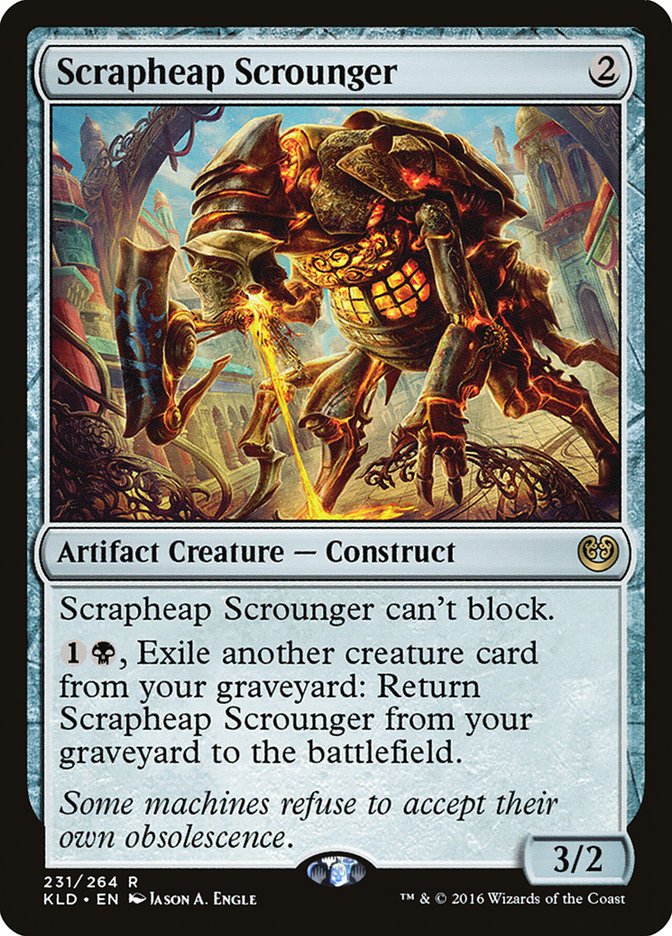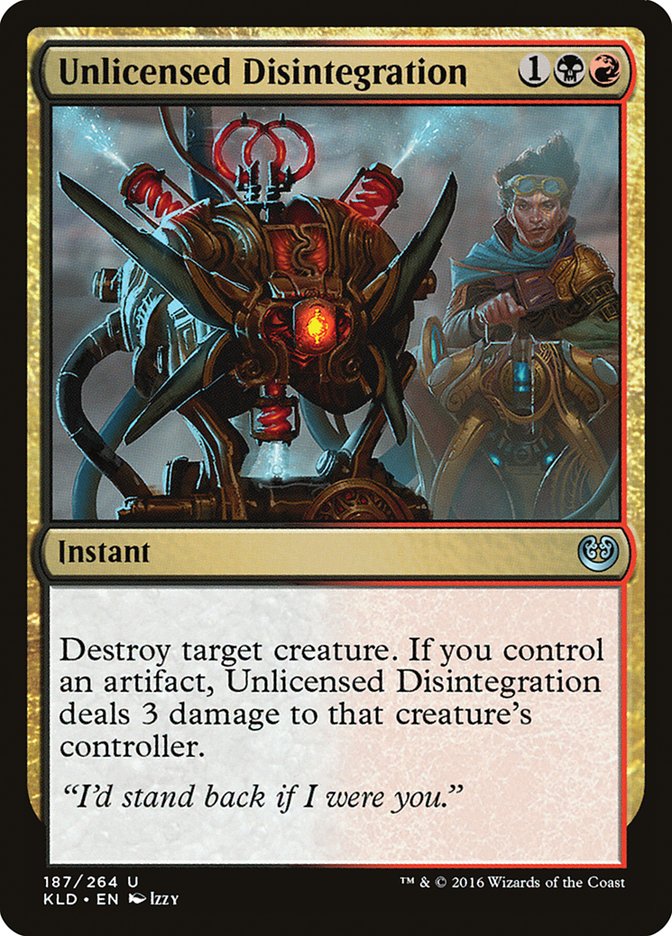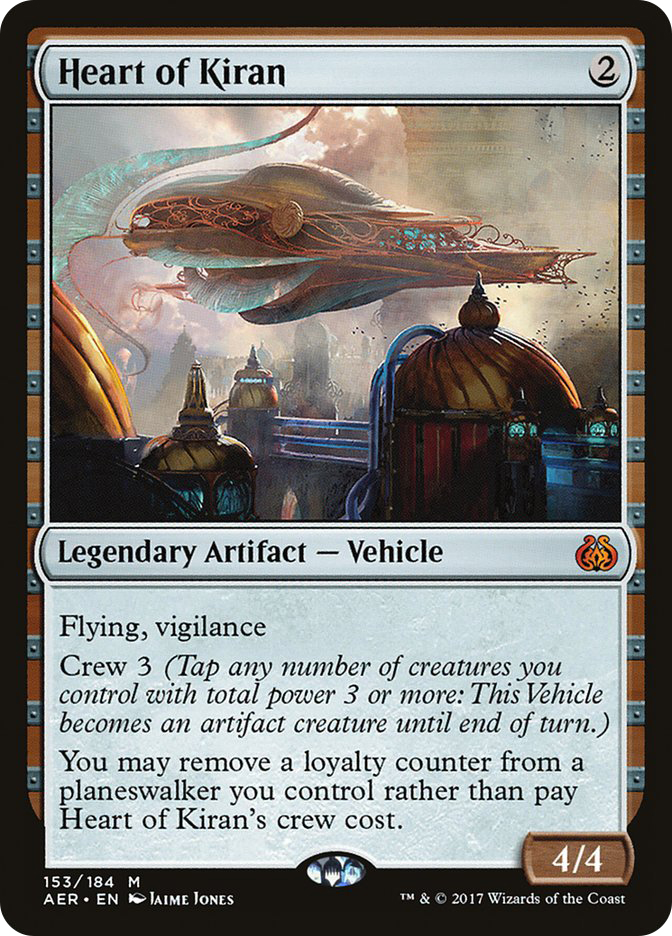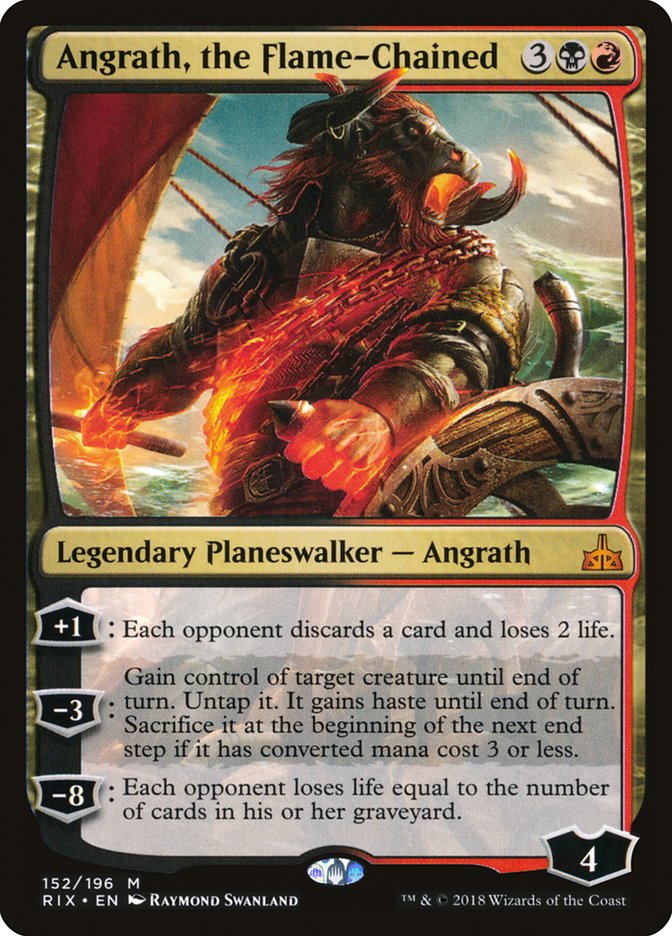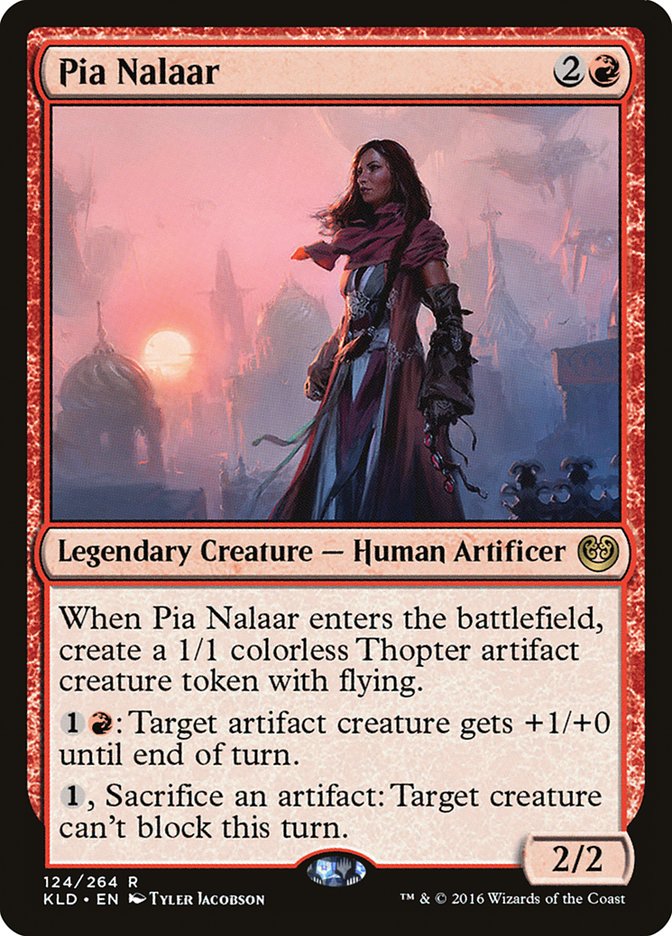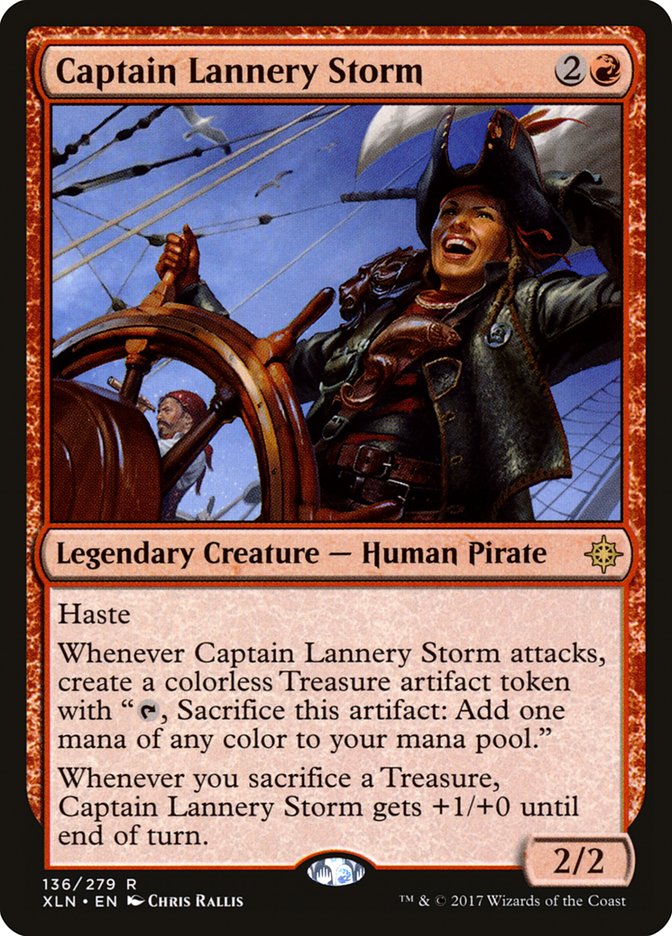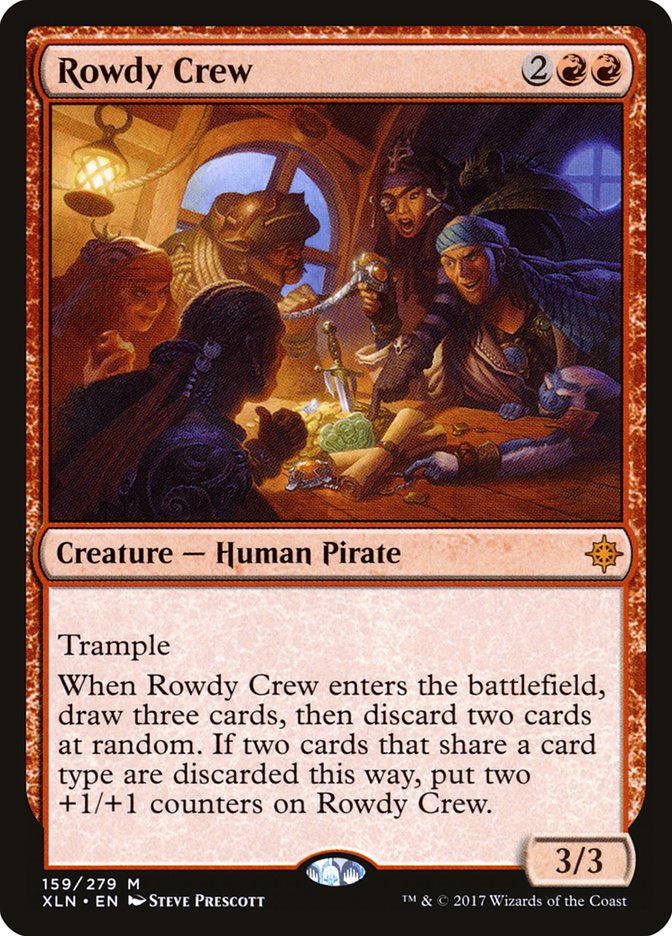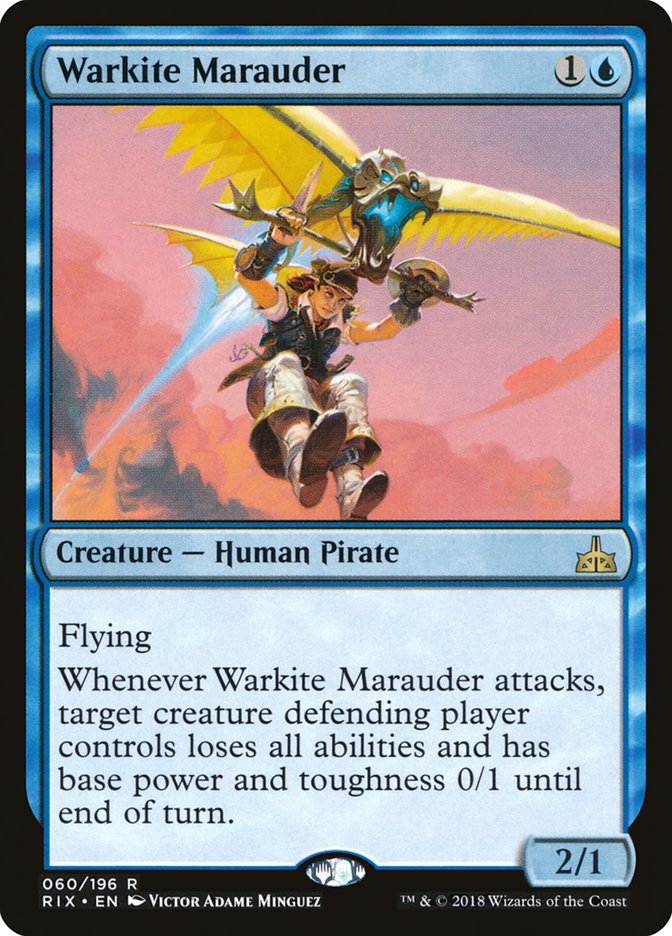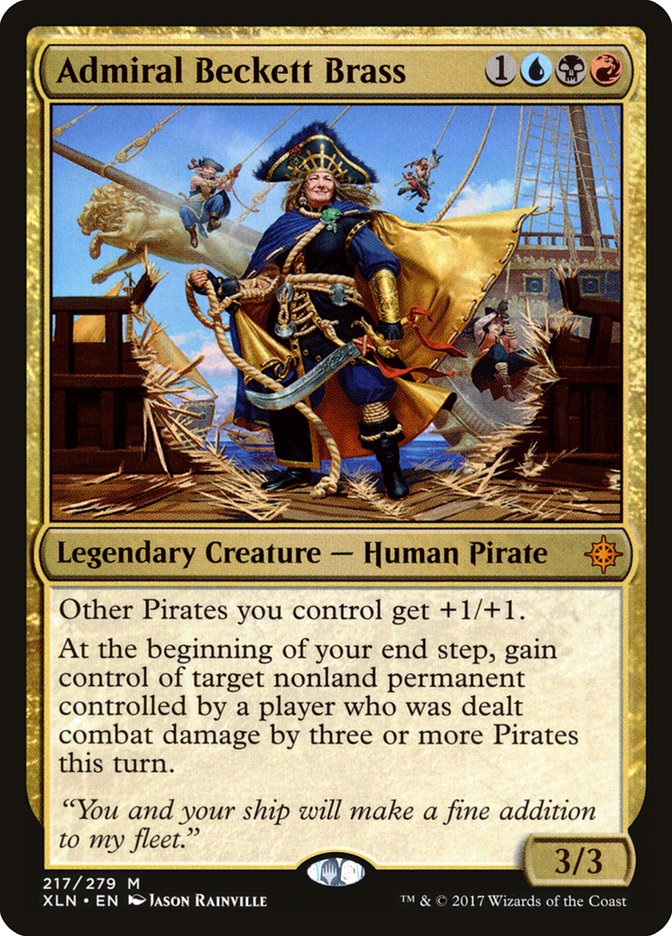We’ve all come to recognize just how powerful the energy cards from
Kaladesh are, but when the set was first released, it was the artifact
theme that was most prominent. W/R Vehicles won the first Standard Open
when the set was legal, and that deck quickly evolved to incorporate a
black splash for two very powerful cards:
The former is an aggressively-costed creature that can come back for more
quite easily, and since its color requirement isn’t relevant until later in
the game when you want to recur it, splashing it in the Boros shell was
quite easy.
But it was Unlicensed Disintegration that was the real prize. Three mana is
about the price we expect to pay for restriction-free removal in Standard,
especially at instant speed, and Unlicensed Disintegration tacks on a free
Lava Spike, a huge gain for answering planeswalkers or to simply pressure
your opponent’s life total in an aggressive deck. For much of the last
year, Unlicensed Disintegration was a premier removal spell in Standard,
but since the rotation of Thraben Inspector as a cheap source of an
artifact, the decks that support it have disappeared.
I’m not ready to give up on such a powerful card, and I think Rivals of
Ixalan has added enough tools to make it work, despite not replacing
Thraben Inspector with another source of cheap artifacts.
The key to unlocking Unlicensed Disintegration is putting it in a shell
where the three damage is most relevant. Initially that looks to be a very
aggressive shell, but that doesn’t need to be the case. Mardu Vehicles
evolved over time from an aggro deck to a midrange deck in part due to
Unlicensed Disintegration making the extra aggression unnecessary. You
could instead use it to turn the corner in a midrange deck, allowing you to
supplement it with more powerful cards.
Unlicensed Disintegration already restricts your deckbuilding by requiring
a certain number of artifacts, and further restricting yourself to the low
curve and high threat density of an aggressive deck results in playing weak
cards like Bomat Courier. I’ve registered Bomat Courier in two sanctioned
events in my life, and both were miserable failures. I’m not going to make
the same mistake again…hopefully.
So I’m looking for a deck that can stand toe to toe in combat with more
powerful decks, but has the ability to deal a lot of incidental damage so
it can punish any stumbling from the opponent or set up to turn the corner
quickly should it fall behind early.
My first pass:
Creatures (13)
Planeswalkers (6)
Lands (23)
Spells (18)
- 3 Lightning Strike
- 1 Key to the City
- 4 Unlicensed Disintegration
- 4 Heart of Kiran
- 3 Renegade Map
- 1 Aethersphere Harvester
- 2 Cut
Sideboard

Heart of Kiran is the natural pairing with Unlicensed Disintegration since
Smuggler’s Copter is banished to the shadow realm, and it of course also
plays nicely with Scrapheap Scrounger. Heart of Kiran also plays well with
planeswalkers that start on high loyalty, which this deck has a pair of in
Chandra, Torch of Defiance and Angrath, the Flame-Chained.
Conveniently, both of these planeswalkers also deal incidental damage to
the opponent. Their +1 abilities Shock and Angrath, the Flame-Chained can
set up big swings with its second ability. I struggled to evaluate Angrath,
the Flame-Chained when I first saw it because its abilities look to pull it
in two different directions. It can generate card advantage but doesn’t
have a high impact on the turn it enters the battlefield, meaning it’s
slow; however, it can generate material advantage over time and also has
the ability to create significant damage output, which makes it seem more
aggressive.
This shell maximizes Angrath’s abilities since it can play to either
extreme, and even in games where you’re aggressively using its +1 to empty
your opponent’s hand, the damage is going to add up when combined with all
the other sources of direct damage this deck has. Lightning Strike,
Cut//Ribbons, Unlicensed Disintegration, and Ramunap Ruins mean that no
life total is safe, putting pressure on your opponent to have an answer
immediately for all of your early threats.
If you land Heart of Kiran into Weldfast Engineer for an early six-point
attack it’s going to be very difficult for your opponent to survive a long
game, but they’re forced to use removal on your threats or fall victim to
Pia Nalaar and Key to the City clearing the way for more big attacks. At
the same time, you have plenty of sticky threats and sources of card
advantage to play an attrition game. The ability to attack on multiple
angles is critical to the success of midrange decks, and this deck does
that very well.
If you wanted to get more aggressive, I think there are enough artifacts to
support Inventor’s Apprentice, but as I noted earlier, I’m not interested
in playing underpowered cards in this shell. However, if you want to be
aggressive, you can make up for that lower power by taking advantage of
tribal synergies.
Since we’re in red and black, Ixalan block is pointing us firmly toward
Pirates. Interestingly, there’s a nice bridge between the tribal and
artifact themes of such a deck in Fell Flagship, a powerful effect that
like much of Ixalan’s tribal cards, hasn’t had enough support to see play.
Creatures (21)
- 4 Scrapheap Scrounger
- 4 Captain Lannery Storm
- 4 Fathom Fleet Captain
- 4 Rowdy Crew
- 4 Daring Buccaneer
- 1 Dire Fleet Daredevil
Lands (24)
Spells (15)

The presence of Fell Flagship means you need to move away from Heart of
Kiran so as to not overload on vehicles, but that just makes room for some
of the two-mana Pirates that are available. I prefer Fathom Fleet Captain
since its menace means it’ll be easier to connect and force your opponents
to discard cards, and it can create more Pirates to leverage the anthem
effect from Fell Flagship.
Being a little more aggressive means a one-drop is more appropriate here
than in the above list, and the Pirate theme allows you to upgrade that
one-drop to Daring Buccaneer. This list has seventeen total Pirates, which
seems a little low to support Daring Buccaneer, but you have to make some
concessions when balancing multiple themes, and I’m not willing to
sacrifice Scrapheap Scrounger. If Fell Flagship were a Pirate vehicle, I
wouldn’t need to worry so I’m just going to blame WotC if it doesn’t work.
In the three slot it’s possible that a split of Pia Nalaar and Captain
Lannery Storm is correct since the former is almost certainly a better
individual card, but I want to start by maximizing the tribal synergies and
then pare down from there. I envision a lot of curves utilizing Captain
Lannery Storm as a four-drop so you can use the treasure token with your
fourth land to Lightning Strike a potential blocker, creating a big attack
that puts your opponent well within burn range.
The last card to talk about here is Rowdy Crew. I wanted a curve-topper
with some size and this deck doesn’t have a lot of card types so it should
be a 5/5 quite often. It plays nicely with Key to the City to deal big
chunks of damage if your early aggression is answered and provides a bit of
card advantage for a deck that is sorely lacking in it since I cut all the
planeswalkers.
The last deck I have with Unlicensed Disintegration is the one that uses it
most sparingly. There are some blue Pirates I’m quite interested in, most
notably Warkite Marauder, and that means splashing Unlicensed
Disintegration, just as Mardu Vehicles did last year.
Creatures (23)
- 4 Scrapheap Scrounger
- 4 Captain Lannery Storm
- 2 Dreamcaller Siren
- 2 Admiral Beckett Brass
- 3 Siren Stormtamer
- 4 Daring Buccaneer
- 4 Warkite Marauder
Lands (21)
Spells (16)

Despite the power of Unlicensed Disintegration, this list only plays three
because the burn spells are incredibly effective in this shell. Warkite
Marauder turns them into Terminates, even for Hazoret the Fervent and The
Scarab God, and Captain Lannery Storm lets you double spell with cheap
removal very early in the game, putting you incredibly far ahead, at which
point a single Unlicensed Disintegration will be enough to end the game.
Warkite Marauder is certainly weak to Whirler Virtuoso, which could be too
much of a problem to overcome, but in the early game it’s unlikely that
your opponent can make more than one Thopter token, so a single removal
spell can get you through until your opponent is in burn range.
The added reach from the cheap burn spells is also important since this is
the most aggressive and thus, least powerful of the three lists I’m
featuring today. There are multiple one-drops and plenty of creatures with
flying so Fell Flagship should be quite effective even if you’re not
crewing it.
The downside is that with a low curve and three colors the mana is quite
tricky, and it’ll take some iterations to find the right balance. It’s
possible that the deck is better off as a straight U/R list so it can
eschew Renegade Map, but the black splash here is very good. Scrapheap
Scrounger and Unlicensed Disintegration aren’t even the entire story since
you also gain access to Admiral Beckett Brass.
Admiral Beckett Brass, even without its second ability, would be quite good
in this deck, but if you ever Confiscate a permanent from a non-control
opponent, the game should end on the spot. Granted, if you’re connecting
with three creatures with a lord on the battlefield you’re well ahead to
begin with, but the threat of the ability will force your opponent into
some awkward blocks, especially in combination with Warkite Marauder. So
I’m willing to believe that the card is overkill and you’d rather have more
copies of Dreamcaller Siren to force through damage, but I’m going to start
by trying the card with the most potential.
Brewing with Rivals of Ixalan is an awkward proposition because we’re
currently awaiting the Banned/Restricted List update coming next week.
Whether or not a key card or two is banned from the energy shell makes a
huge difference in how we have to approach new cards and decks. Right now
the ability to compete with Rogue Refiner and friends is the most important
metric on which to evaluate new decks, but that could completely change if
it or Attune with Aether is on its way out.
That said, Unlicensed Disintegration is one of the cards that has competed
and come out even or ahead of Energy. Mardu Vehicles was arguably the best
deck in Standard last winter and while it was Gideon, Ally of Zendikar that
got most of the press, Unlicensed Disintegration was as important a piece
to the deck’s success.
So brewing around a card that has already proven itself against the worst
case scenario is a great place to start. Whether or not Temur Energy as we
know it remains a deck, Unlicensed Disintegration and Scrapheap Scrounger,
supplemented by some important new cards, should be able to compete in
Standard.
And it’s that cross-block supplementation that I like most about these
decks. The recent blocks have all been so disjointed as to create a
Standard format where the top decks are found by picking a block and
building around the themes of its most powerful cards. But limiting
yourself to the card pool of a single block is a huge concession in
deckbuilding, and I prefer to find places where different blocks can
overlap and support each other. Kaladesh may be an objectively more
powerful block than Ixalan, but that doesn’t mean the former has to
dominate the latter.
So when you’re building your own post-Rivals decks, look back at the other
blocks in Standard and see where you can find common ground. Your results
will be a higher individual power level with little or no sacrifice in
upside from synergy.


